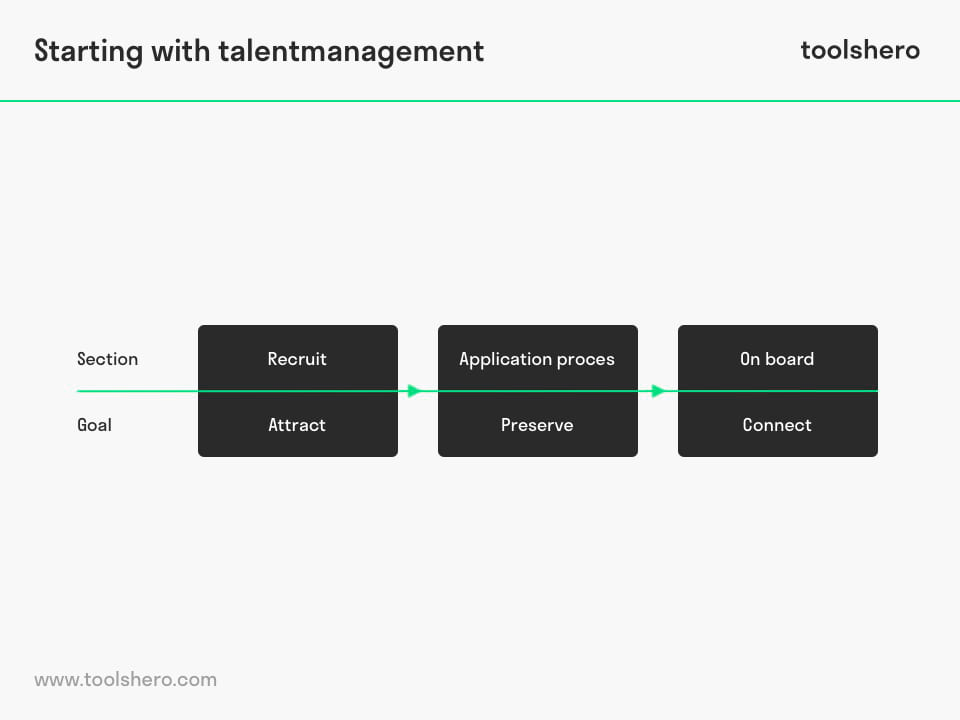Talent Management: Process and Steps

Talent Management: this article provides an explanation of the term Talent Management. After reading, you will have a better understanding of this important part of Human Resource Management (HRM), with the goal to optimise the performance and competitive power of companies. This HRM method makes it possible to match the skills the company needs and the skills that are available amongst the employees with each other: knowledge, skills and personal characteristics, both individual and shared. Enjoy reading!
What is Talent Management?
Talent Management is aimed at people within an organisation by determining and developing their special aptitude, qualities and ambitions in a certain field. Subsequently, a suitable position is sought, so talents are optimally utilised. In doing so, it’s important that the circumstances lead to creations that allow talents to bloom.
Why Talent Management?
Optimally utilising the talents of all employees helps the organisation achieve its objectives.
This given the fact that employees work based on their strength and in doing so are able to provide a better contribution to the organisation.
Customers will notice the effect of satisfied proactive employees and this will improve customer satisfaction. And this, in turn, results in more profit and growth of the organisation.
Additionally, good talent management ensures connection and motivated employees. This because you offer employees the possibility to utilise their skills in activities they’re good at and that are motivating. You create insight and invest in your people.
Finally, when your employees leave the organisation, they will speak positively about you, which in turn means you will more easily attract new talent.
Important Reasons to Invest in Talent Management
1. Investing in the right people and reducing undesired turnover
Of course, it’s important that the right people are hired. But the right candidates are often incorrectly rejected.
2. Retaining good employees and utilising their talents
Nowadays, organisations do increasingly more work with fewer people. Therefore, talent development has become increasingly important. Additionally, employees, particularly those of the younger generations, also set higher demands regarding development.
In practice, we see that only employers that offer development opportunities succeed in retaining their top employees.
3. Making the organisation future-resistant on all levels
Behaviour arises from talent. Therefore, a change in the organisation starts by having insight into talent. Because without behavioural change, there’s no organisational change.
4. Timely readying successors to key positions
It’s becoming increasingly important to pay attention to the internal transitions of talented employees. By establishing early on which employees can grow within the organisation, you can invest in their development.
5. Talent management increases productivity
Having motivated employees increases productivity. Therefore, it’s important to let your employees know what they’re good at and give them the opportunity to become even better. This results in smoother processes, increased productivity and decreased absence through illness. In short, more is achieved with fewer people.
6. Talent management is CSR
The term Corporate Social Responsibility (CSR) is impossible to ignore nowadays.
Increasingly more organisations engage in CSR. CSR stands for a sustainable balance between ‘People, Planet and Profit’, or the social, environmental and economic aspects. Helping people to grow by letting them do what they’re good at is part of the sustainable utilisation of the human success factor. The social component of corporate social responsibility.
7. Talent management yields money
If talent management is used in the right way, it provides a competitive advantage in all fields and that also means money:
- Opportunities in the market are filled in faster.
- There is less turnover: employees who fit within the organisation stay, employees who don’t, leave will leave on their own accord.
- Good company image. Scarce talent is more easily recruited.
- More is achieved with fewer people.
- Investing in development leads to face as you invest in the talents that employees possess and that the organisation needs.
HubSpot’s Guide to Choosing a Recruitment CRM for Your Business
Getting Started with Talent Management
Recruit (Attracting), Job interview & Selection (Retaining) and On board (Binding).

Figure 1 – Talent Management steps
Recruit
The process of generating a pool of qualified candidates for the job vacancy:
- Planning: why, what and how?
- Vacancy: announcement of the opportunity
- Communication: shared information between parties
Job Interview
Is a kind of selection test that entails a meeting between an applicant and employer:
1. Create clear expectations
- Create a clear idea of effective behaviour for your vacancy. What behaviour makes an employee more successful in your organisation?
2. Uncover the candidate’s talents
- Discover the specific talents and motivators by asking the right questions, such as:
A. What can the candidate do?
- Skills
- Strengths
- Capacities
B. What does the candidate want to do?
- Type of person
- Talents
- Motivators
- Interests
When asking the above questions, it’s important that you make the candidate feel at ease, so he/she can give authentic answers to the questions.
Additionally, it’s also important to let the candidate speak freely as much as possible. You shouldn’t talk more than 10 minutes every hour during the interview.
Summary of the job interview (for employer)
3. Combine talents and expectations
Because you now know what specific behavioural competences you expect for the vacancy, keep the following principles in mind:
- Create clear behavioural expectations
- Discover the talents (strengths, talents and easy-to-achieve competences that the candidate can convert into performances)
Selection Based on Step 3 Above
Selection tests are procedures for determining a candidate’s suitability for a position. These have two goals:
- Uncovering an applicant’s undesired characteristics
- Identifying characteristics related to the position
On Board
- Process of acclimatisation of employees to the organisation and their work
- Offers access to tools and sources that are required to succeed
- Quickly feeling welcome and appreciated by the organisation and set up a personal development plan
Now it’s your turn
What do you think? Are you familiar with the explanation about talent management or do you have anything to add? When do you think this model is effective? What do you believe are important success factors that contribute to the practical application?
Share your experience and knowledge in the comments box below.
More information
- Blass, E., Knights, A., & Orbea, A. (2008). Developing future leaders: The contribution of Talent Management. In Leadership Learning (pp. 181-199). Palgrave Macmillan, London.
- Kehinde, J. (2012). Talent management: Effect on organization performances. Journal of Management Research, 4(2), 178-186.
- Unknown. (2024). HubSpot’s Guide to Choosing a Recruitment CRM for Your Business. Retrieved 01/07/2024 from HubSpot: https://www.hubspot.com/products/crm/recruiting.
- Silzer, R., & Dowell, B. E. (Eds.). (2009). Strategy-driven talent management: A leadership imperative (Vol. 28). John wiley & sons.
How to cite this article:
Sari, J. (2018). Talent Management. Retrieved [insert date] from Toolshero: https://www.toolshero.com/human-resources/talent-management/
Original publication date: 06/07/2018 | Last update: 01/07/2024
Add a link to this page on your website:
<a href=”https://www.toolshero.com/human-resources/talent-management/”> Toolshero: Talent Management</a>












